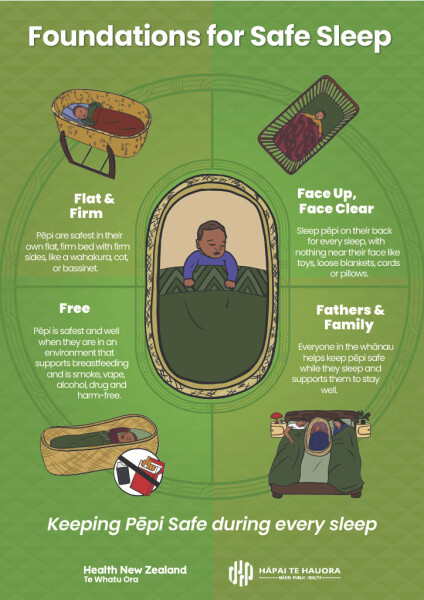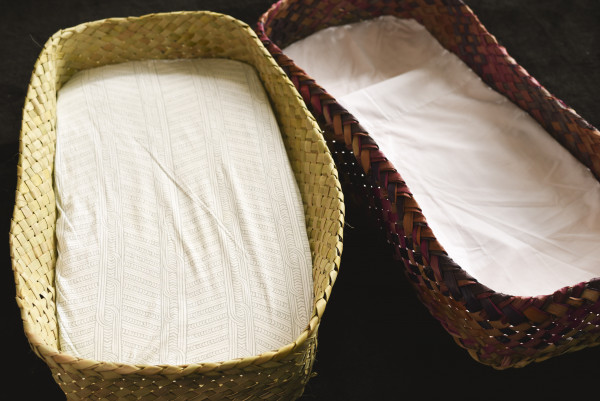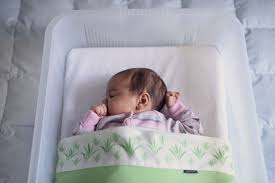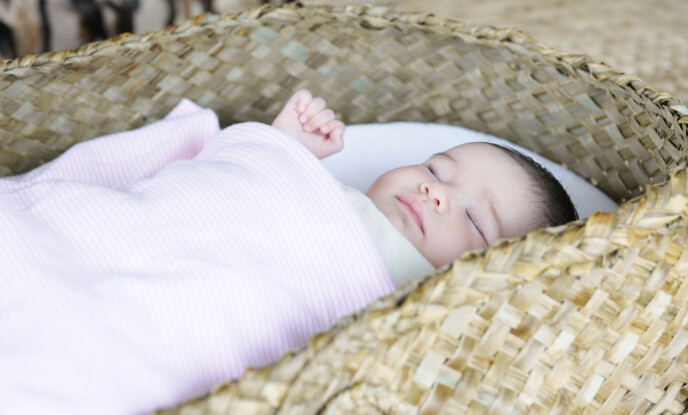Safe sleep
Every sleep should be a safe sleep for babies, and this means giving them their own safe sleeping space.
Until they’re 12 months old, pēpi are vulnerable to SUDI (sudden unexpected death of an infant). It’s defined as the sudden and unexplained death of an infant during sleep, and each year, it affects 40 to 50 babies. In many cases, death or injury could be prevented by using safe sleep practices.
SUDI is frightening for new parents to think about, but it's important to know the facts and to know the steps you can take to reduce the risk for your baby.
The Foundations for Safe Sleep include:
- Flat and Firm. Pēpi are safest in their own flat, firm bed with firm sides, like a wahakura, cot, or bassinet
- Face Up and Face Clear. Place pēpi on their back for every sleep, with nothing near their face like toys, loose blankets, cords, or pillows
- Free. Pēpi is safest and well when they are in an environment that supports breastfeeding and is smoke, vape, alcohol, drug, and harm-free
- Fathers & Family. Everyone in the whānau helps keep pēpi safe while they sleep and supports them to stay well.

Baby beds: separate sleeping spaces
Bassinet
Many families and whānau use bassinets for their new baby. Normally sitting on fixed legs or casters, bassinets provide a completely separate sleeping space for your baby.
There are a lot of different makes and models of bassinets available in New Zealand. Look for one that has a firm flat mattress, no more than 40 millimetres thick (as it could be a suffocation hazard.) The mattress needs to fit flush to all edges of the bassinet.
Cot
Many families and whānau choose to use a bassinet before using a cot. Cots also offer a separate sleeping space for your baby. Pēpi need to transition to a cot once they can push up or roll over.
There are mandatory safety standards for cots.
When you’re looking for a cot to buy, check it’s displaying a safety standards sticker so you know it complies with the standards. Cots sold in New Zealand must meet the requirements of safety standard AS/NZS 2172:2003. If you’re unsure when you buy the cot, have a chat to an expert in the store when possible. If you’re buying or are given a second-hand cot, it must meet the mandatory safety standard too.
There are two height settings for the base of most modern cots. When the baby is quite small, the high base involves less bending for adults. The lower base is used when your baby is more mobile. When your child is showing signs of rolling and sitting up, it's time to consider moving the base to the lower position.
Portacots
Portable cots (portacots) aren’t covered under the mandatory standard for household cots and are designed to be used as temporary solutions for rest or sleep when travelling or visiting. It's recommended that when a baby will be left unsupervised for regular sleep times and overnight, they should be in a cot or other sleeping environment that complies with an Australian New Zealand standard.
To ensure safe use of a portacot as a temporary sleep space:
Follow the manufacturer's instruction for use, including securing the mattress to the cot frame if required
Make sure the mattress fits snugly. There must be no more than a 25mm gap between the mattress and the side of the cot. Do not add an extra mattress.
Check regularly for any holes in the fabric or loose catches - repair or replace at the first sign of wear.
Read more about safety standards for household cots (PDF)
Baby beds: safe bed-sharing options
If you choose to sleep in bed with your baby, put them in their own baby bed beside you.
Wahakura
The wahakura is woven from flax and enables whānau to keep baby close, including during sleep.
Wahakura are designed so you can sleep next to pēpi and see them over the top of the basket.
Wahakura are a taonga, entrenched in Māori customs and marae values. Wahakura raranga (plaiting) and whiri (braiding) weaving techniques ensure it stays strong, the base stays flat, and the sides won’t collapse.

Image courtesy of Hāpai te Hauora
Guidelines for wahakura change according to the region where they’re made.
You’ll need a 20-25mm foam mattress with a cotton cover, and you need to make sure there are no gaps between the inner wall of the wahakura and the mattress. The National SUDI Prevention Programme's National Safe Sleep Device guidelines provides a summary of guidelines (PDF) for weaving a wahakura.
Pēpi-Pod®
The Pēpi Pod® is made from polypropylene, a food-grade plastic, fitted with a mattress and bedding.
It’s designed so you can share a bed with your baby, while keeping baby safe from accidental suffocation.

Pēpi-Pod®
If you don’t have a baby bed, ask your midwife, doctor, or Plunket nurse for help to get one. If you’re on a low income, you might be able to get help from Work and Income.
Keeping your baby’s bed safe
Baby’s bed is safe when:
- it has a firm and flat mattress so your baby’s airway is open when lying flat on their back
- there are no gaps between the bed frame and the mattress that your baby could become trapped or wedged in
- there are no loose straps, ribbons, or cords attached to the bed frame
- baby is in the same room as you or the person looking after them at night for their first six months
- it is checked regularly to ensure it is structurally sound, there are no loose parts, and all manufacturers' instructions have been followed.
These things aren’t safe to use in your baby’s bed:
- pillows and cushions (if your child is at least two years old, a small firm pillow can be used)
- loose blankets, sheets, covers or other loose bedding (under the age of two years)
- bumper pads (pads that attach to the ends and sides of cribs)
- loose ribbons, ties or threads on a baby’s clothes or sleepwear
- toys, teething necklaces, or anything they could suffocate or choke on
- sheepskins aren’t suitable if your family/whānau has a history of asthma or allergy, because they can collect house dust mites. If you want to use a sheepskin, use a short-hair type, and cover it with a sheet.
Check that wahakura, Pēpi Pods®, bassinets, cots and children's beds are away from items with strings or ties, like:
- hanging mobiles
- blind cords (these cords should be wrapped around cleats or safety devices attached to the wall at least 1.6m off the floor)
- curtains
- pictures or wall hangings.
Make sure wahakura, Pēpi Pod®, bassinets, cots and children's beds are away from:
- walls and furniture such as dressers and cupboards
- power points
- heaters
- pets
- other children.
Sleep positioning aids
Whānau Āwhina Plunket does not endorse any sleep aid or sleep positioning products, as they can limit baby's natural development and ability to get themselves out of an unsafe sleep position. However, as a parent you have the right to make your own decision.
If you decide to use one of these products, follow the manufacturer’s instructions to make sure you are using the product correctly and safely. Check their website or contact them directly with any questions about their product.
Keeping baby warm in bed
Your baby’s room should be:
- well-aired with the door open, especially if you use a heater
- warm but not too hot - it should feel comfortable for a lightly-clothed adult. It’s a good idea to use an electric heater with a thermostat, because fan heaters can overheat a room and gas heaters can release dangerous fumes.
To make sure your baby is warm enough in bed:
- use more clothing layers on your baby in cooler weather, rather than adding more layers of bedding. That way your baby can wriggle around in bed while staying safe and warm.
- if you use a blanket:
- make sure it’s lightweight and securely tucked in under the mattress, and that it can’t come loose or cover your baby’s face
- place your baby near the foot of the cot to stop them slipping down under the covers. Keep their face clear of covers by tucking them in firmly.
- once baby tries to roll over, then stop swaddling or swaddle with arms free
- if you use sleep sacks, consider discontinuing once your child transitions to a regular or children's bed, as it may increase their risk of a fall
- if you use any warming devices (like hot water bottles), make sure they are used safely:
- always remove hot water bottles or wheat bags from the bed and check the area is not too hot before you put your baby in. Wheat bags can overheat so take extra caution with these.
- do not use any heating products near where the child's face would be
- heat pads, electric blankets and electric toppers are not recommended for use in children's beds. If you are using them, make sure they are turned off and unplugged from the wall before the child goes to bed.
You can check your baby’s warm enough by putting two fingers on the top of your baby’s back. If it's warm, then they're warm enough. If your baby's back is hot or sticky, take off a layer or take off some covers.
Read more about choosing suitable nightwear and bedding for your tamariki.
Making your child’s bedroom safe
Your child’s sleep space should be safe and appropriate to their age – it could be a secure cot, or in a bed with a safety rail.
Cot safety as your baby grows
As your infant becomes more active in the cot, such as rolling or climbing, we encourage parents to routinely and regularly inspect the cot drop side to ensure it remains in its slide mechanism, and that the mattress is fitted snugly.
Toddlers are curious, and some might start trying to escape their cot by climbing over the railing. Look for things they could use as a step – like toys they could pile up, or bumper pads – and make sure they’re out of the cot at sleep time.
If your child can climb out of the cot, make sure the cot mattress is on the lowest possible setting. If it’s already on the lowest setting and they’re still trying to – or can – get out of the cot, it may be time to move them to a bed with a side rail.
It’s okay for toddlers and older children to sleep with their security items – their blankie or special toys – as long as they’re small and can’t smother them. Always check for choking hazards which may become sharp, loose or come off when sucked.
If you’re unsure, talk to your Plunket nurse or midwife to check your child’s sleeping space for any hazards.
Bedroom safety
To make sure your baby’s bedroom is safe, particularly before you move your child into a bed:
- use plug/socket covers so your child can’t stick anything in them
- always keep sharp objects out of reach of children
- put stickers on glass windows and doors at your child’s eye level so they don’t hurt themselves
- cupboards, doors, and door hinges can hurt children’s fingers. Using door guards can help protect them from injuries
- make sure heaters meet New Zealand safety standards, and keep them a safe distance from your child’s bed
- install safety locks on windows so they only open a little bit, and make sure the gap isn’t big enough for your child to climb through
- secure any hanging cords - including mobiles with hanging strings - because they're a strangulation hazard. Wrap blind and curtain cords around clips or cleats attached to the wall at least 1.6m above the floor so your child can't reach them.
- make sure all furniture (e.g., bookshelves, wardrobes, and other heavy objects) is sturdy and secured or anchored to the wall using brackets; pad sharp corners of furniture with foam or corner protectors
- keep any medicines, cleaning products, and anything else poisonous out of the bedroom, out of sight, and out of reach, along with choking hazards like coins and small batteries
- check the bed (cot or bed) regularly to ensure it is structurally sound, there are no loose parts or straps (e.g., straps on slat bed frames), and all manufacturers' instructions have been followed.
- If you’re unsure, talk to your Plunket nurse or midwife to check your child’s sleeping space for any hazards.
See Moving from a Cot to a Bed for advice on transitioning out of the cot to a child's bed.
Need support with sleep and settling?
Call PlunketLine free on 0800 933 922 to speak with one of our friendly nurses. We also offer free, private online consultations with nurses specially trained in sleep and settling support for your pēpi.
